ORLANDO, Fla. — The whiplash of uncertainty has buffeted the nation’s charter school movement during the past five years. First, COVID-19 disrupted learning for millions of students . That was, followed by restrictions on federal grant money. Then came a lawsuit challenging the public status of charter schools.
The leader of the National Alliance of Public Charter Schools empathized as the movement’s annual conference kicked off on Monday.
“Starting, running and teaching at a charter school has never been easy,” the alliance’s CEO Starlee Coleman said during her keynote speech to more than 4,000 charter school representatives. She said plenty of changes lie ahead.
“Some of the changes you’re going to like, and some will be hard.”
But charter school supporters also had plenty to celebrate, including the sector’s growth alongside private school choice, students who outperformed district peers on national tests, and state laws that require charters to receive a share of capital funding. The U.S. Department of Education also infused an additional $60 million into the fund for charter schools, bringing the total to $500 million to support charter school expansion.
Leaders also hailed the opportunities created by the rise of private school education savings accounts, or ESAs, which have skyrocketed in popularity in states that have passed them.
“Choice is working. Choice is here to stay,” said Hanna Skandera, CEO of the Daniels Fund and a former secretary of education in New Mexico. Skandera was one of a four-member panel that discussed the future of charter schools.
Leaders in Texas and Florida discussed how to seize those opportunities by offering a la carte courses to students with ESAs. Florida, where in 2023 lawmakers made all K-12 scholarship programs into ESAs that are universally available and created the Personal Education Program for students not enrolled full-time in a public or private school, has already recruited school districts and charter schools to provide access to part-time classes. The latest to sign on is Charter Schools USA, which announced a collaboration with Step Up For Students earlier this week to expand options for students.
"This is the future, and it's great to see,” said Derrell Bradford, president of 50CAN and who serves on several charter school boards. “These sorts of collaborations are what happen when families are in the driver's seat, and they have real resources to direct the education of their children. I hope more states and providers follow them on the path to educational pluralism."
Texas won’t start offering its ESA program until 2026, but in preparation a coalition of charter school leaders has already started a pilot program for private-pay students at four schools. They offer a la carte classes online and in person, including some after school.
“We think this is an opportunity, not as a threat,” said Raphael Gang, K-12 education director at Stand Together Trust.
The panel advised those considering offering part-time services to capitalize on their strengths when deciding what to offer, start small and educate parents on how to access the programs.
In Florida, where education choice scholarship programs have been in place since 1999, representatives shared the history leading up to the state’s 2023 passage of House Bill 1, which converted all choice scholarships into ESAs and made them available to all K-12 students. That law also established a new ESA, the Personalized Education Program, for students who are not enrolled full-time in a public or private school. PEP allows parents to use $8,000 per student to create a customized education for their children.
“It has been a game-changer,” said Keith Jacobs, assistant director of provider development at Step Up For Students. Jacobs, a former charter school leader, works to recruit and onboard charter schools and school districts as providers of part-time services for ESA students.
Jacobs said school choice used to exist only for families who could afford private school tuition or buy a home in a certain ZIP code, but ESAs have taken choice to a new level.
“We have placed the funds in the hands of the parents,” he said.
What does that look like?
It might be a virtual class in the morning, band at a public school in the afternoon, and a session with a private tutor.
“Or it might be ‘My child needs an AP bio class and the charter school down the street has a good bio teacher,’” he said.
Charter Schools USA Florida Superintendent Dr. Eddie Ruiz said the decision to offer courses to part-time students was easy given the demand for flexibility.
“Charter Schools USA believes in innovation,” Ruiz said. “It’s given parents the flexibility to really design their student’s education.”
He said when he approached his principals about the idea, they wondered how it could be done. Ruiz compared it to Amazon.
“Parents can just pick and choose,” he said. “Whatever it may be, they design their educational experience.”
The implementation will look different for each state based on the laws, but in Florida, approved providers can list their offerings and prices on an online platform, where parents can purchase the services with their ESA funds.
Charter schools set their prices based on local costs, said Adam Emerson, executive director of the Office of School Choice for the Florida Department of Education. In calculating those, leaders should not overlook operational costs, such as putting the students in the school information system.
Emerson said serving ESA families is a financial win for charters, but also the chance to make a positive difference for students in their communities.
“Yes, it’s a revenue stream, but it’s also a calling,” he said.
Harvard professor Roland Fryer took to the pages of the Wall Street Journal recently to urge lawmakers and advocates to reinvigorate the drive to Milton Friedman’s vision of a dynamic demand-drive K-12 system:
Today’s school-choice ecosystem, which one might refer to as “market lite,” has helped thousands of families. But millions are waiting, and current choice programs operate within the same inadequate framework. Increasing choice on the margin through partial vouchers, magnet school or other measures has yielded disappointing results because of an imperfectly competitive market. Real competition doesn’t mean entering a lottery to attend a charter school or providing vouchers worth only a fraction of public-school funding.
Only a small number of states have adopted enough “market lite” proposals, in combination, to begin to realize the potential of an education system driven by families and supply by educators. Fryer puts his finger on the problem directly:
School choice as currently implemented is more patchwork than panacea. It’s like getting to pick between a government-run cafeteria and an alternative where the line is long and, more often than not, the dish you were hoping for has run out by the time you get to the front. Friedman envisioned a nation of all-you-can-eat buffets.
Every waitlist, in other words, is a policy failure. Fryer expresses enthusiasm for education savings account programs, and ESAs are indeed potentially less limited by supply constraints. The details however matter greatly: formula funded ESA programs have the transformative potential Fryer extols, whereas a program limited by annual appropriation seems likely to produce the dreaded waitlists.
The reality is that upper-income Americans have been investing in multi-vendor education at a growing rate for decades. Private spending on enrichment activities, including tutors, Kumon, summer camps, private lessons, Mathnasium, club sports and far more.
If you’ve ever felt exhausted by driving your kids around after school, or compared notes with other parents on this, you have been a part of this trend. Scholars have documented upper-income Americans spending approximately $9,000 per child per year on enrichment activities. How much credit do leafy suburban schools deserve for their monopoly on non-embarrassing scores on international achievement exams? No one can say for sure, but it may not be as much as commonly assumed.
The significance of the enrichment trend became apparent only after the onset of the COVID-19 pandemic. Advantaged American families still paid exorbitant mortgage ransoms to access the best public schools, but they were not entirely relying upon those schools. Increasing numbers of families have correctly discerned that the opportunity cost of attending a district is simply too high.
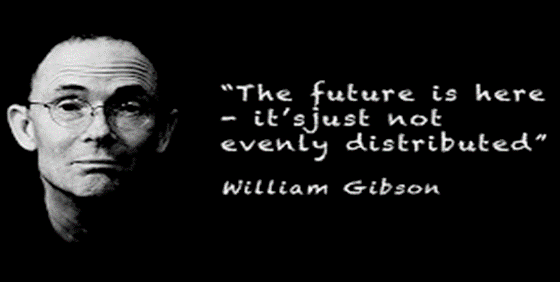
Demand driven education is here — it’s just not evenly distributed. Policymakers in some states have democratized the opportunity to participate through ESAs, which have the transformative potential Fryer extols. Elite families will continue to engage in multi-vendor education with or without ESAs, but states with well-designed programs will share such opportunities across society. The future is indeed here; will we distribute it?

Last week, I watched a panel hosted by Harvard University on “Emerging School Models: Moving from Alternative to Mainstream.” During the discussion, John Kirtley of Step Up For Students noted that Step Up had allowed ESA families to purchase paddle boards because they were a useful form of balance therapy for children with disabilities. Kirtley noted that children with disabilities could develop balance and strength because they fall in the water without getting hurt.
“We saw that as a legitimate physical education activity,” Kirtley said. “I guess that was viewed differently by others.”

Stand Up Paddle Boarding Aquatic Therapy (SUPAT) is in fact a therapy that is being practiced and is being formally evaluated in medical journals, for example, regarding benefits for students with cerebral palsy:
These findings support the notion that the SUPAT program is beneficial for increasing gross motor function, improving balance, and decreasing the number of falls. SUPAT could be a viable alternative therapeutic intervention to traditional aquatic therapy and an opportunity to participate in an outdoor sport.
A Georgia newscast segment provides a glimpse into SUPAT therapy in action.
“We are showing them the world that doesn’t need to be inside a clinic,” program instructor Alyssa Walz explained. “A paddle board is an unstable surface, so just sitting on the board, even if you are not doing anything on the board, you are working on your core.”
According to the segment, paddle board therapy provides an activity “where you can stand tall and independent in a world that might focus on the things you cannot do.”
"How do I know it's working? I see it! I see kids go from not being able to stand on an unstable surface to standing on the paddle board standing by themselves,” Walz said.
Alas, there has been no small amount of effort put into scoring cheap political points, both by choice opponents and by journalists. For example:
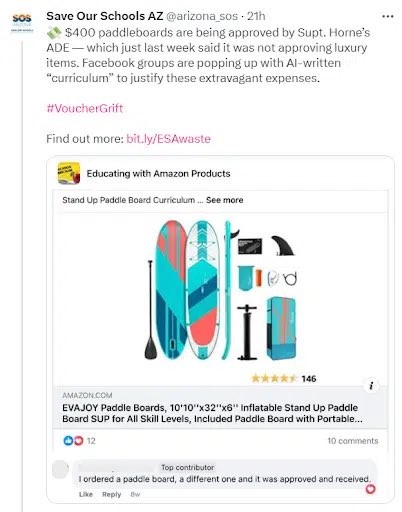
Journalists tend to be drawn like moths to a flame to something that sounds controversial and don’t always bother to gather much in the way of context. Here is an example:
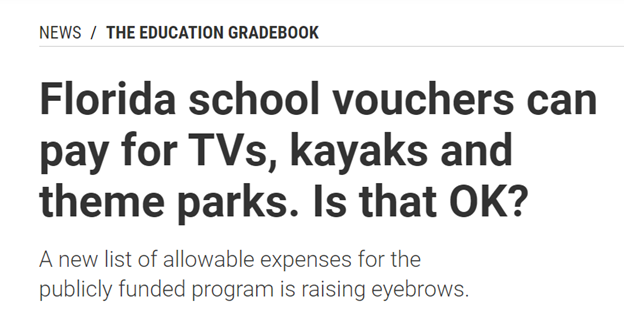 The much dreaded “raised eyebrow” can at times translate into “repeating uninformed grousing by opponents eager to take things out of context.” As Alan Kay once famously noted:
The much dreaded “raised eyebrow” can at times translate into “repeating uninformed grousing by opponents eager to take things out of context.” As Alan Kay once famously noted:

In a discussion of this issue on the platform formerly known as Twitter, Isabella Lopez, the parent of a child with a disability noted:
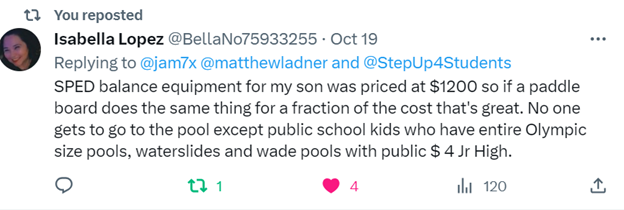 Lopez makes a crucially important point: it is of unspeakable importance to give people the space and flexibility to try new approaches. Experimentation is literally the engine driving progress: novel approaches that improve the human condition. The ESA mechanism gives families the incentive to maximize the utility of funding by seeking not just good education services, but the optimal services for the individual needs of a particular child.
Lopez makes a crucially important point: it is of unspeakable importance to give people the space and flexibility to try new approaches. Experimentation is literally the engine driving progress: novel approaches that improve the human condition. The ESA mechanism gives families the incentive to maximize the utility of funding by seeking not just good education services, but the optimal services for the individual needs of a particular child.
SUPAT, thus must compete with other techniques-Equine therapy for example, which is also used to develop core body strength for students with disabilities and has also been the subject of poorly thought-out efforts to discredit ESAs. I’ve even seen grousing from choice opponents that public school students don’t often get access to innovative therapies.
Whose fault would that be? Remember that most ESA students are only receiving a fraction of the average weighted total per pupil funding provided to students in districts. Could it be that hopelessly complex bureaucratic structures with overlapping and sometimes contradictory local, state and federal governance authorities are not the ideal context for innovation?
In any case, dear reader, you’ll continue to see this sort of grousing from opponents, and the allure of a controversial headline will be too much for reporters to resist. Just recall going forward that for any ESA purchase, context is crucial.
The Covid-19 pandemic exposed a contradiction.
On one hand, remote learning and school closures were devastating to students and their learning. Partial reopening or "hybrid" schedules may have been even worse. Aggressive actions by some state and district leaders to reopen schools and return students to classrooms are looking smarter in hindsight.
At the same time, the pandemic accelerated a trend that had already been picking up steam. Some families are eschewing full-time school, choosing new options that blur the lines between schooling and homeschooling. A growing number of hybrid schools have begun catering directly to their needs, offering part-time schedules where students meet on campus a few days a week, or a few hours a day, and spend the remaining time learning at home (or in the woods, on the water, at the museum, on the farm, or other places).
For some families, this is the best of both worlds. They combine the flexibility of homeschooling with the socialization, childcare and pedagogical guidance offered by schools.
Surveys by EdChoice show a surprisingly large number of families like having their children at home for at least one day during the school week, and the National Hybrid Schools Project has documented the proliferation of learning environments that match their preferences.
In theory, hybrid and part-time schools could be a natural fit for education savings accounts that allow families to direct publicly funded scholarships to a mix of education-related goods and services of their choice. Hybrid schools' less-than-five-day schedules often mean tuition is lower than at typical private schools, and ESAs allow families to use any remaining funds on curriculum, tutoring, enrichment activities or supplies to supplement their schools' programming.
In other words, hybrid schools jibe with two key features of ESAs: Giving families the flexibility to tailor a mix of learning opportunities to individual children and giving them an incentive to economize and put their limited scholarship funding to the most effective use.
In practice, however, learning environments that straddle the boundaries between schooling and homeschooling bump into policy barriers. Many states, for example, require schools to deliver a certain number of hours of instruction per year, or to meet students on campus a certain number of days per year.
As a result, hybrid schools may not be eligible for tuition payments through ESA programs in many states. According to a new policy report published last week by ExcelinEd, of the 16 states with active ESA programs, only seven afford some avenue for hybrid schools to qualify for private school tuition funded through ESAs. And even some of those fall short of the potential. Several states require eligible private schools to be accredited, which could pose a barrier to some hybrid schools. Utah's program does not allow parents to roll over any leftover ESA funds for future school years. This "use-it-or-lose-it" design limits some incentives to economize.
Hybrid schools may qualify for funding by other means. For example, they may meet requirements to bill parents as part-time tutoring providers or through provisions in some state laws that allow Department of Education officials to approve expenses that meet the intent of scholarship programs but aren't expressly authorized.
This is a next-generation question for states that have enacted ambitious education choice programs that allow families to direct public education funding to providers of their choice. What appropriate regulations will ensure all students have access to the instruction and support they need, while accommodating the proliferation of innovative models that blur the lines between schooling and homeschooling and allow parents to assemble education from multiple providers?
It's a safe bet that in the coming years, state policymakers around the country will look for new ways to strike the right balance.
Go deeper: ExcelinEd's Ben DeGrow explains how hybrid schools could help meet the demand in many states for new options that cater to families who use ESAs. The National Hybrid Schools Project's annual surveys provide insight into the growing movement.
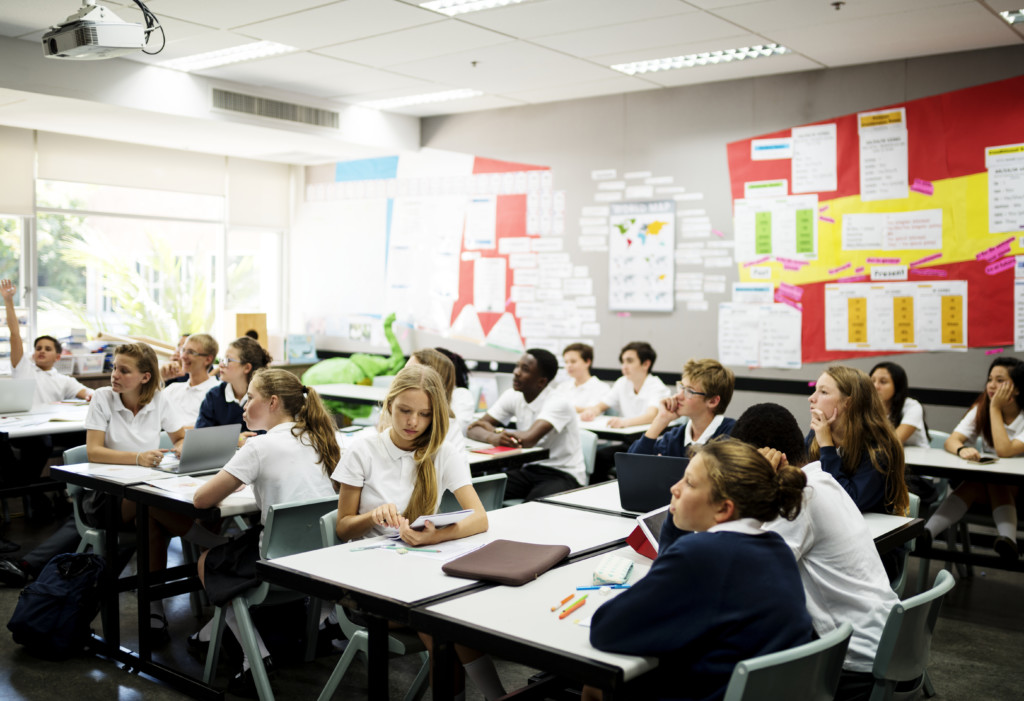
Editor's note: This post was originally published in the The Hechinger Report.
What is the best way to teach? Some educators like to deliver clear explanations to students. Others favor discussions or group work. Project-based learning is trendy. But a June 2023 study from England could override all these debates: the most effective use of class time may depend on the subject.
The researchers found that students who spent more time in class solving practice problems on their own and taking quizzes and tests tended to have higher scores in math. It was just the opposite in English class. Teachers who allocated more class time to discussions and group work ended up with higher scorers in that subject.
“There does seem to be a difference between language and math in the best use of time in class,” said Eric Taylor, an economist who studies education at the Harvard Graduate School of Education and one of the study’s authors. “I think that is contradictory to what some people would expect and believe.”
Indeed, the way that the 250 secondary school teachers in this study taught didn’t differ that much between math and English. For example, math teachers were almost as likely to devote most or all of the hour of class time to group discussions as English teachers were: 35 percent compared to 41 percent. Lectures were one of the least common uses of time in both subjects.
The study, “Teacher’s use of class time and student achievement,” published in the Economics of Education Review, gives us a rare glimpse inside classrooms thanks to a sister experiment in teacher ratings that provided the data for this study. Teachers observed their colleagues and filled out surveys on how frequently teachers were doing various instructional activities.
To continue reading, go here,

SailFuture, a private high school, started as a mentoring program for at-risk youth by teaching them maritime skills through sailing adventures. It recently was named as one of 32 semifinalists for the $1 million Yass Prize to be awarded in December.
Consulting firm Tyton Partners, in collaboration with the Walton Family Foundation and Stand Together Trust, today released a new report, Choose to Learn 2022, that looks at data collected from more than 3,000 K-12 parents and more than 150 K-12 suppliers across all 50 states in the United States.
The report finds that 52% of parents now prefer to direct and curate their child’s education rather than rely on their local school system, and 79% of parents believe learning can and should happen everywhere as opposed to in school alone. Data shows that parents want experiences that make their child happy, above all else, by reflecting their child’s interests and providing individual academic support. However, despite all parents reporting similar goals for their children, regardless of demographics, the study reveals gaps in program participation across income and race. For example, children from underserved backgrounds are nearly two times less likely to participate in learning outside of school than their peers.
Choose to Learn 2022 explores the variety of K-12 options now available to families – inclusive of both in- and out-of-school educational offerings – and how this ecosystem can better reflect families’ broader aspirations for their children. The publication follows recent findings from Tyton Partners’ School Disrupted 2022 series, which highlighted the near 10-percent decline in district public school enrollment due to the lasting impact of the COVID-19 pandemic.
“In viewing K-12 through a broad lens, we set out to better understand the issues impacting every family, including more than forty million parents who send their children to public school,” according to Christian Lehr, Senior Principal at Tyton Partners and the lead author of Choose to Learn 2022. “Relative to issues of equity and access, our local public districts play a crucial role for K-12 families. At the same time, families crave a wide variety of learning experiences. It is in this spirit that we examined parents’ aspirations at the intersection of in- and out-of-school learning, and ask: How can the K-12 sector deliver a stronger union of academic, extracurricular, and personal outcomes for all families, regardless of life or economic circumstances?”
Based on these findings and more identified in this study, it is clear now more than ever that parents want an education centered on the needs of their child, yet there is continued work that needs to be done to bridge the gap between aspiration and reality. It is incumbent upon the K-12 system of policymakers, system leaders, and suppliers to introduce new experiences, choices, and outcomes into local school districts and catalyze the growth of programs outside of school and across all demographics.
Choose to Learn 2022 underscores the need for the K-12 system to move towards a more student-centric future and helps readers understand how to:
“We are honored to have the opportunity to drive this pivotal conversation forward, alongside our partners, the Walton Family Foundation and Stand Together Trust,” according to Adam Newman, Founder and Managing Partner at Tyton Partners. “There is a clear call for us to collectively build towards a more student-centered future in K-12 education.”
To view the findings and learn more about this study, download Choose to Learn 2022 on the Tyton Partners website.
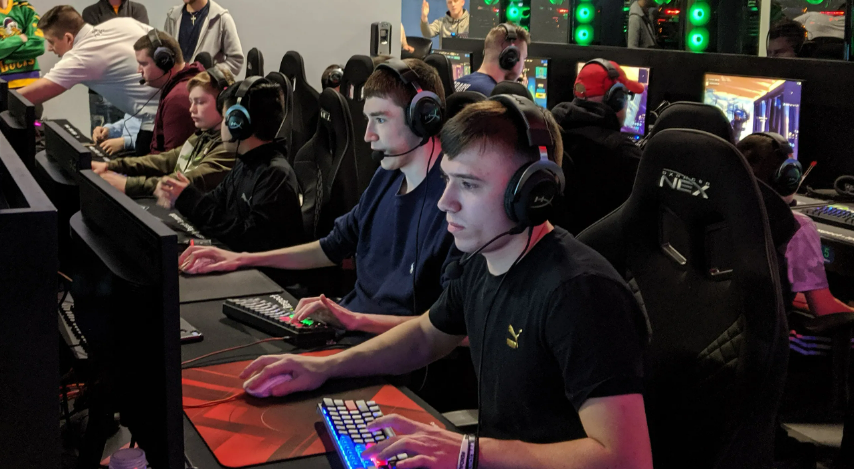
Uptime Esports, which operates a middle and high school extended learning program at one of its three New Hampshire locations in partnership with the local school district, is a recent addition to the Learn Everywhere roster and teaches a variety of skills relevant in the job market.
Editor’s note: For a list of frequently asked questions about Learn Everywhere, click here.
High school sophomore Eli George plans to pursue a career in finance or engineering, and he wants to get in as many STEM courses as possible before graduation. But he also must fulfill the state’s requirements to earn a high school diploma.
In New Hampshire, where his family lives, that means logging a physical education credit. The 15-year-old had completed an adventure course, but he needed another P.E. course by the end of his junior year, which crowded his schedule and left him unable to take an advanced computer science elective.
“He wanted to broaden his education,” said his father, Shawn George.
Eli was able to do that, thanks to an innovative program the New Hampshire Legislature approved in 2018. Called Learn Everywhere, the program allows students to earn credits outside the classroom while pursuing their interests at state-approved providers in their communities.
Here’s how it works. Students who complete programs approved by the state board of education receive a competition certificate, which they can submit to their schools. The school must accept the coursework for credit, freeing the student to opt out of the corresponding school class so he or she can take a different class.
Eli, who with his father has practiced martial arts at a local dojo for six years, satisfied his P.E. requirement by coming for lessons three times a week.
“It’s a good opportunity for the student and the school,” said the elder George, who learned about Learn Everywhere from his sensei, Aaron Cass, a fifth-degree black belt who teaches high school English in a nearby community.
The dojo only recently got approved as an education provider and Eli is its first student, but Cass praised the program and hopes to see more students participate.
“The biggest challenge is how to get the word out,” said Cass, who added a page about Learn Everywhere to his website.
That effort includes informing district schools, including some that have been slow to understand the new legislation that mandates the awarding of credit to students who meet the requirements.
“We went back and forth for about a month with his guidance counselor, who talked to the principal and said, ‘We don’t have extended learning,’” Cass said.
State Department of Education officials interceded, reaching out to the superintendent and clarifying that the program was mandated by state law. The district finally awarded Eli his P.E. credit.
Because the program is new and just now being broadly marketed, the situation isn’t unusual, said Timothy Carney, educational pathways administrator for the New Hampshire Department of Education’s Bureau of Education Opportunities, which administers the Learn Everywhere program.
The coronavirus pandemic and a resulting lack of resources delayed state efforts to get the program up to full speed after a contentious approval process. That meant fewer education options and fewer students in the beginning.
Carney’s job is to help change that. He is meeting with school district leaders and potential Learn Everywhere providers to spread the word about the law and the opportunities it creates for schools, community organizations and students.
“Some of the feedback I got from providers was that they hadn’t heard anything from the DOE since (Learn Everywhere) got approved,” Carney said. “They had a number of questions, and so they hadn’t been very aggressive.”
As for districts that questioned students’ completion certificates, “the Department hadn’t done a lot of outreach to explain what the program was,” Carney said.
After Carney’s outreach, most districts came around quickly. “It was just a disconnect,” Carney said.
News stories from 2019 detail the major controversy that ensued when the state board of education was considering rules to govern Learn Everywhere. Democrats and teacher unions strongly opposed the program, saying it stripped control from local districts, some of which had established their own extended learning programs.
Those groups also questioned allowing non-certified teachers to be instructors for credit-granting programs. But the state program, which Education Commissioner Frank Edelblut proposed after observing an evening robotics club at a school, was a way to extend opportunities that were available to students in only some districts statewide.
In 2020, the state board ultimately approved the rules after a yearlong delay caused by the challenges.
Today, Learn Everywhere has 12 approved programs, ranging from Sylvan Learning Center to the Russian School of Mathematics to Friends Forever International, which includes training in leadership and global understanding.
Uptime Esports, which operates a middle and high school extended learning program at one of its three locations in partnership with the local school district, is a recent addition to the Learn Everywhere roster and teaches a variety of skills relevant in the job market.
“They learn about gaming and other things,” Uptime Esports co-founder Tim Schneider said. “They learn PC building, social media awareness and game design. A lot of things in our gaming program are tied to STEM-based learning, so there’s a lot of people who are into these topics.”
Plus, Schneider said, a lot of colleges have established esports teams and offer scholarships to the best players.
Carney is continuing to recruit providers among community groups. For example, a church with a strong choral program could offer music credits. That could help a student who wanted to take a music class at school but whose schedule was too full of required core classes.
To address critics’ concerns about quality, the program must meet certain standards and outlines the skills students must show mastery of to earn the credits. The provider is also required to show how it will accommodate students with disabilities to gain state approval.
Some bugs remain. Not all provider offerings are free, which drew criticism from opponents who argued that lower-income students wouldn’t be able to participate. At least at this time, none of New Hampshire’s three education choice scholarship programs, including an Education Freedom Account Program, allow funds to be spent on Learn Everywhere programs.
Some providers do offer financial aid to qualifying families, though, and Carney is looking for a funding source to help lower-income families.
‘We’re hoping to be seen as a resource rather than a threat,” he said.
 Words such as voucher, privatization, profit and corporation are often used as weapons by individuals and groups who oppose parental empowerment and school choice. Using words as weapons is especially common during periods of significant social change - we all do it - but the practice undermines civic discourse and makes finding common ground more difficult.
Words such as voucher, privatization, profit and corporation are often used as weapons by individuals and groups who oppose parental empowerment and school choice. Using words as weapons is especially common during periods of significant social change - we all do it - but the practice undermines civic discourse and makes finding common ground more difficult.
“Market” is another term school choice opponents use to connote evil, but our way of life is largely based on markets, and public education is increasingly embracing market processes as customized teaching and learning become more common. Our challenge moving forward is regulating public education markets in ways that maximizes their effectiveness and efficiency.
People access products and services in one of two ways. Either their government assigns them, or they choose for themselves. In the United States, we have historically allowed citizens to choose, and this system of provider and consumer choice is a “market.”
In a goods and services market, providers decide which goods and services they want to sell, and consumers choose those they want to buy. Markets, when implemented properly, are preferable to assignment systems because they better utilize people’s knowledge, skills and motivation. Citizens are allowed to use their own experiences and judgments when making selling and purchasing decisions, and this citizen empowerment maximizes the universe of ideas from which improvement and innovation derive.
When governments assign products and services to their citizens, they rely on a small group of people to decide what to offer. This top-down approach is less open, transparent and effective than the decision-making that occurs in markets, and it discourages creativity. This is why most improvements in goods and services emerge from market systems rather than government assignment systems.
Markets allow providers to learn from consumers. When governments dictate to consumers what goods and services they may have, their citizens’ true wants and needs are not fully considered. The voice of the customer is silent. But when consumers are empowered to choose for themselves, providers learn from these choices and adjust accordingly. In markets, this necessity to meet customers’ needs drives innovation and continuous improvement. (more…)
Call them Vouchers 2.0. In the age of customization, researcher Matthew Ladner sees education savings accounts as the tool for the times. Unlike vouchers or tax credit scholarships, ESAs would allow parents to use state funds to pay for a blend of K-12 educational options – schools, tutors, online programs, etc., in whatever combo works - and perhaps squirrel away some of those funds for college.
“We we like to say that ESAs are sort of school choice and parental control over education down to the last penny,” Ladner said in a podcast interview with redefinED. “What we really want to do is allow parents to customize the education for their child. Education shouldn’t be necessarily an all or nothing proposition - you’re either attending this school or that school. In fact, the whole definition of what a school is is being fairly rapidly changed by technology.”
Ladner is senior advisor of policy and research at the Foundation for Excellence in Education. He’s one of the creators of the ESA concept and its most diligent Johnny Appleseed. In October, the Friedman Foundation for Educational Choice published a report he authored about ESAs called, “The Way of the Future.” Ladner also was instrumental in creating the ESA program in Arizona, which to date is the only one in the country but was recently expanded.
A key feature of ESAs, Ladner said, is that it requires parents to make choices based on quality and price. That in turn will spur innovation and, at the same time, reign in costs that have risen steeply for decades with little improvement in academic outcomes. “If you want to reverse that, you have to do something that’s going to seem a little radical at first,” Ladner said. “But by giving parents complete control over the money and requiring them to consider possible alternative uses for that money, it really sets them up to be discriminating consumers.“
Florida lawmakers flirted with ESAs in 2011, with critics panning the idea as “universal vouchers” and “vouchers for all.” But Ladner said even if a state went “whole hog” with the idea, the vast majority of kids would remain in public schools, as the Florida experience has shown with McKay vouchers and tax credit scholarships. In his view, ESAs should also be designed for equity - with greater funding for students with greater needs.
Are people ready for ESAs? Maybe not just yet, Ladner said. But it took a while for people to catch on to Palm Pilots, too. “As a movement we always need to be taking a strong interest in the development of our product. And our product in this case is our methods to increasing the freedom and the effectiveness of parents the parents within the schooling system,” Ladner said. “I think there is work to be done. But I do think that when this work is done we will have a product that is clearly superior to the ones we have today.”
A few months ago, 13-year-old ninth-grader Giovanni Munnerlyn was in a public middle school in Tampa, Fla., being shuffled from one math class to another. He felt like giving up on the subject. His mom felt helpless. But last night, he and Mom (shown here) sat side by side in the computer lab at his new school, Gateway Christian Academy, taking on numbers that used to be his nemesis.
On the screen in front of him, math problems adding fractions were being served up by Khan Academy, the California-based phenomenon that is turning heads with its educational videos.
“Find the common denominator,” Giovanni said softly to himself before typing in an answer. The Khan Academy’s response: Smiley face. Giovanni squeezed his hand into a victory fist.
This little moment in a little school reflects a bigger project helping kids like Giovanni.
The new school year marks the beginning of a partnership between Khan Academy, which has drawn flattering coverage from “60 Minutes” and The New York Times, and Step Up For Students, the Florida nonprofit that administered 40,000 scholarships last year to low-income students. If I could narrate this story like Sal Khan narrates one of his videos, I’d say in his calming, authoritative voice, “Cutting-edge technology … plus school choice … equals more opportunity for low-income kids.” I’d use one of Khan's colored pens to underline the word “opportunity.”
The venture is one of only a handful that Khan Academy has forged with school systems nationwide. It’s the only one in the Tampa Bay area, and it’s the only one outside of California with a private school network. The pilot involves math instruction at 10 private schools in the Tampa area, all of which accept tax credit scholarships.
Khan Academy’s interactive tools, including thousands of short, engaging videos, are available for free to anyone who wishes to use them. But the partnership schools get additional materials so their teachers can even more effectively pinpoint where students are falling short – and then efficiently get them up to speed.
For schools in the Step Up partnership, there’s also a parental engagement piece. (more…)